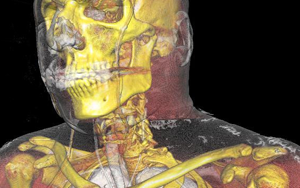 The ImageVis3D team is proud to announce the release of ImageVis3D 2.1.1.
The ImageVis3D team is proud to announce the release of ImageVis3D 2.1.1. DOWNLOAD NOW
ImageVis3D is a desktop volume rendering application which was designed to visualize large data. Support is available for multiple rendering modes, such as 1D and 2D transfer functions, isosurface rendering, as well as specialized modes such as MIP and slice views. On modern systems, ImageVis3D's GPU-accelerated rendering delivers incredible performance, while compatibility options exist to allow ImageVis3D to perform adequately on older systems.
ImageVis3D 2.1.1 is a minor release, concentrating mostly on bugfixes. Changes since 2.1.0 include:
New Features
- Added support for GeomView files.
Bugs fixed in this release
- Fixed ClearView crash.
- Fixed clipping plane transformations. Clipping planes now behave as they did prior to 2.1.0.
- Fixed a crash which could occur when converting MetaMorph files.
- Fixed a data corruption bug when converting from certain types of 'wide' data types.
Changes which are only of interest to developers
- Transitioned to C++11.
- Clang is now the default compiler on Mac.
Known issues with this release
- There is a known issue converting color data in a single TIFF file.
- The 'Stack' ("stk"), single-file TIFF volume, and Fraunhofer EZRT ("rek") file formats can only be read, not written.
- The 'Brick Of Values' (BOV) reader does not support BOVs in which the data are split across multiple files.
- RGB[A] are the only kinds of multicomponent data supported.
- NVIDIA GPUs on Linux expose a driver issue which can hang the system for prolonged periods of time. To workaround this issue, we recommend sticking with the slice based volume renderer Linux for this release.
- Full-color data sets do not display a proper histogram in the transfer function editors.
- In any mode but MIP, the 'Recorder' always uses the highest resolution data, regardless of any other settings.
- In the "Disable LOD" mode of MIP Recordings, progress information is not given. Progress is being made; a visibly-correct rendering is not required to create an on-disk image which is visibly correct.
www.imagevis3d.org
The ImageVis3D Developer builds site
The 'sci' PPA on Launchpad (Linux only)
or you can get the source directly from our subversion repository, using the 'svn' command:
svn co https://gforge.sci.utah.edu/svn/imagevis3dor any other subversion client.We look forward to your feedback! Like us on facebook:
http://www.facebook.com/pages/ImageVis3D/280651915286334
comment on our wall, or talk to us on this mailing list!
ImageVis3D (IV3D) Mobile 4.0
The ImageVis3D development team also recently released ImageVis3D (IV3D) Mobile 4.0. IV3D Mobile is a mobile visualization application designed to visualize and share volume and surface data while you are on the go. With ImageVis3D (available for free at www.imagevis3d.com) and ImageVis3D Mobile you can transfer your own data directly from the desktop to your mobile device. ImageVis3D supports all iPads, iPod touches and iPhones (older devices have a more limited feature set).This new version is mostly a rewrite of the core features of the application. We made the new version look mostly like the old one but used the opportunity to add a bunch of new features. The new design also makes many things easier so you can expect more exciting new features in the near future.
New Features:
- slice viewer for volumes
- load/save/reset support for transfer functions
- increased performance for rendering transparent geometry
- single tab in render window now hide/shows the bottom tab bar
- support for landscape orientation in the menu views
- proper display of selected secondary and primary dataset in the dataset menus
- integrated web browser so looking at the manual does not kick the user out of the app
- improved interruptible rendering
- a number of new info messages (e.g. a warning when trying to open the tf editor but only meshes are rendered)
- faster dataset switching
- volume LOD parameters (e.g. low res on interaction) are now automatically disabled when only geometry is rendered
- dataset lists now also display the type (geometry or volume)
- smoother transitions from landscape to portrait and vice versa
- integrated user manual for offline reading
